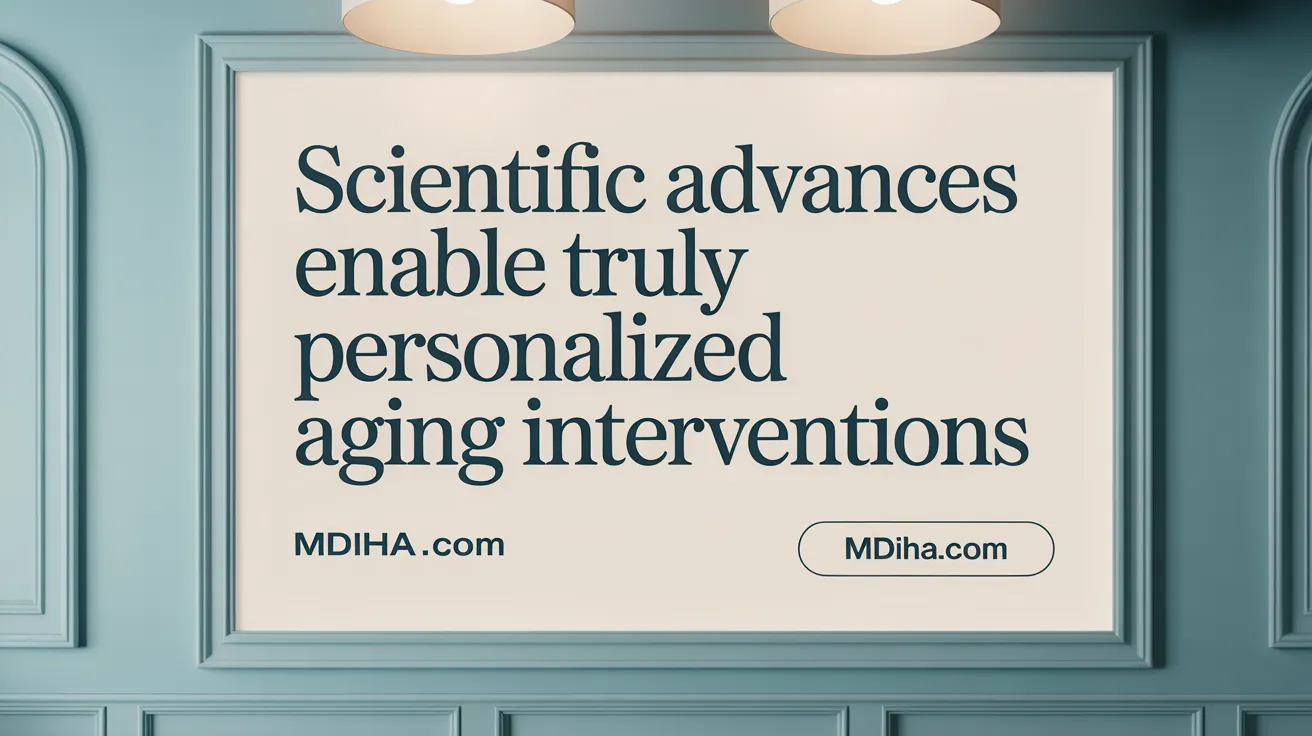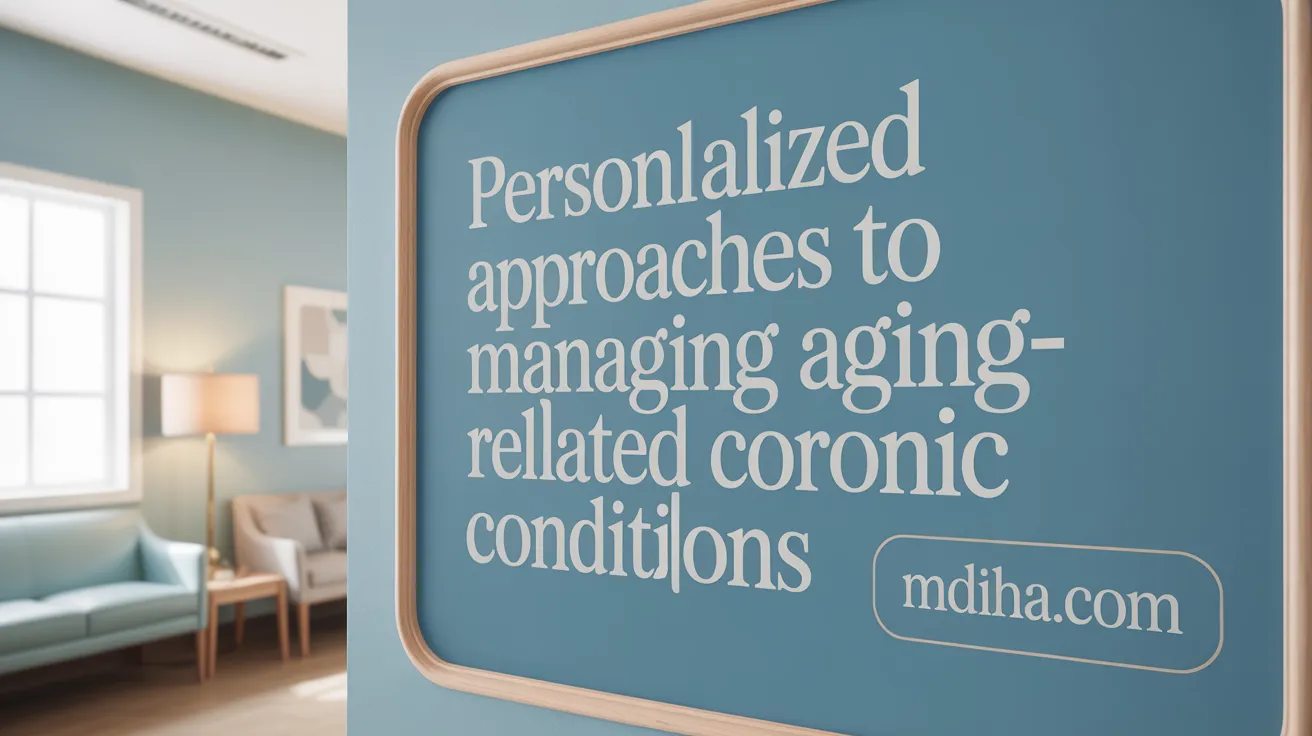The New Era of Aging Well
As global populations age, the quest to extend not just lifespan but healthspan—the years lived in good health—has taken center stage. Recent scientific advances and personalized medicine are transforming traditional approaches to aging, focusing on dynamic, data-driven healthspan plans. These customizable protocols, grounded in cutting-edge diagnostics and tailored interventions, promise to improve aging outcomes by preventing chronic diseases, preserving function, and enhancing quality of life.
Understanding Healthspan: Beyond Longevity to Quality of Life

What is healthspan and how does it differ from lifespan?
Healthspan is the period of life during which a person remains healthy and free from significant chronic diseases or disabilities. Unlike lifespan, which simply counts the total years lived, healthspan focuses on quality — maintaining physical, mental, and social well-being. Extending healthspan means living longer while staying active and independent, rather than just increasing the number of years alive. Learn more about what is healthspan and how can you maximize yours and the difference between healthspan and lifespan.
Current healthspan trends and challenges
Despite increases in average global life expectancy—from around 47 years in 1950 to over 73 years today—many individuals spend nearly a decade or more living with chronic conditions such as cardiovascular disease, diabetes, or dementia. The U.S., for example, has seen a recent decline in average healthspan from 65.3 years in 2000 to 63.9 years in 2021. This lag between lifespan and healthspan is known as the healthspan gap.
Chronic diseases, multimorbidity in older adults, and frailty lead to increased disability, healthcare costs, and reduced quality of life. Social determinants such as socioeconomic status, healthcare access, and social isolation further impact healthspan, often widening disparities. For insights into social determinants of health and older adults, see related resources.
Why is extending healthspan important in today’s aging society?
As populations age worldwide—with the 60+ age group projected to nearly double by 2050—there is a pressing need to address not just how long people live but how well they live. Extending healthspan can prevent or delay the onset of chronic diseases, reducing the years spent in poor health and the associated economic burden on healthcare systems. The WHO facts on ageing and health provide valuable context on global aging trends.
Improving healthspan supports independence, reduces the risk of disability, and enhances well-being for the elderly. It also relieves societal and family caregiving pressures. Public health initiatives targeting modifiable risk factors like inactivity, poor diet, and smoking could prevent up to 80% of non-communicable disease deaths.
Focusing on healthspan emphasizes proactive, preventive care, integrating personalized medicine and lifestyle changes, to compress morbidity and promote healthy aging throughout life. Explore strategic and scientific approaches in the Strategic Framework for Aging in the United States and the science of extending healthspan.
The Science Behind Customized Healthspan Plans

Biomarkers and diagnostics in aging
Modern healthspan plans begin with sophisticated diagnostics that analyze a broad array of biomarkers associated with aging and disease risk. Comprehensive blood panels assess metabolic health, inflammation levels, hormone balance, immune function, and autoimmune markers. These tests, performed in certified laboratories, provide a detailed snapshot of an individual's biological age beyond their chronological years. This allows healthcare providers to identify early signs of declining organ function or inflammation and develop tailored strategies to prevent progression.
Use of molecular and biological clocks
Innovative biological clocks, such as epigenetic and proteomic organ clocks, estimate the aging pace of various tissues and organs at the molecular level. These clocks measure changes in DNA methylation patterns or protein expression that correlate with aging processes. By tracking these indicators, clinicians can quantify the biological aging rate, monitor the effectiveness of interventions, and adjust personalized health protocols accordingly to optimize aging trajectories.
Role of AI and advanced analytics in personalization
Artificial intelligence plays a pivotal role in integrating vast datasets including genetics, biomarker results, lifestyle habits, and environmental exposures. AI-powered algorithms analyze these multidimensional inputs to predict disease risks and identify the most effective intervention points. This technology enables dynamic adjustments to healthspan plans, ensuring they evolve with the patient's changing biology and goals. The result is a precision approach that aims not only to extend lifespan but enhance the quality of healthy years lived.
These scientific advances collectively enable a customized, data-driven pathway for optimizing healthspan, transforming aging care from reactive to proactive and personalized management.
Comprehensive Diagnostic Assessments: The Foundation of Personalization

What diagnostic tests underpin customized healthspan protocols?
Personalized healthspan programs start with detailed online assessments for health goals to capture individual health goals and history. These assessments are then complemented by extensive laboratory diagnostics, measuring over 100 biomarkers encompassing metabolic, cardiovascular, hormonal, immune, and inflammatory domains. Hospital-grade diagnostics further include advanced imaging such as DEXA scans for body composition and full-body MRI to offer a thorough health snapshot. This multifaceted testing process allows practitioners to precisely identify risks, establish baselines, and tailor interventions uniquely suited to each patient.
How do dynamic, ongoing diagnostics improve the effectiveness of healthspan plans?
Continuous monitoring through periodic lab tests—typically every few months—enables healthspan care teams to track changes in biomarker profiles over time. This ongoing data collection supports dynamic adjustments in treatment plans, including medications, supplements, and lifestyle strategies aimed at healthy aging and disease prevention. By responding to evolving health status and goals, these adaptive protocols maintain optimal alignment with the patient’s needs, enhancing overall effectiveness and fostering sustained healthspan improvement.
Types of diagnostics used
- Blood biomarker panels covering metabolic health, inflammation, hormones, and immune function
- Imaging techniques like DEXA and MRI scans for structural and functional insights
- Functional assessments evaluating mitochondrial efficiency and cognitive health (mitochondrial function and autophagy)
Lab testing for over 100 biomarkers
Testing involves comprehensive panels measuring markers such as glucose, cholesterol, inflammatory indicators (hs-CRP), hormones (thyroid, testosterone), autoimmune markers, and others. These results are analyzed to detect early disease risks, metabolic imbalances, and biological aging markers (Advanced Biomarker Analysis, aging-related biomarker testing).
Importance of ongoing lab analysis and dynamic protocol adjustment
Regular reviews allow for precise treatment optimization, ensuring safety and efficacy as conditions change. Licensed physicians oversee these adjustments, making personalized healthspan care both responsive and scientifically grounded.
Personalized Intervention Strategies: Precision in Aging Care

What personalized interventions are commonly used to enhance healthspan?
Personalized healthspan optimization involves a blend of targeted medications, lifestyle changes, and advanced supportive therapies.
Medications such as rapamycin for healthy aging and metformin are widely studied for their potential to slow biological aging and delay age-related diseases. Rapamycin can delay ovarian aging and modulate cellular senescence, while metformin has promising anti-aging properties currently under clinical investigation. Supplements like NMN enhance cellular energy by boosting NAD⁺ levels, supporting mitochondrial and metabolic function.
Lifestyle interventions focus on nutrition, physical activity, and sleep. Anti-inflammatory diets rich in whole, plant-based foods reduce chronic inflammation, a driver of aging and related diseases. Regular exercise—including aerobic, strength, and high-intensity interval training—improves cardiovascular health, cognitive function, and metabolism. Sleep optimization and stress management techniques such as meditation further contribute to healthy aging.
Regenerative therapies are becoming integral to personalized aging care. These include stem cell therapies and aging, platelet-rich plasma (PRP), and exosome treatments to repair tissue and enhance recovery. Supportive treatments like red light therapy benefits, cold plunges, and breathing techniques promote circulation, reduce inflammation, and improve resilience.
Together, these personalized protocols adapt dynamically using biomarker data and patient feedback to maximize healthspan and vitality.
Integrating Technology and Telemedicine for Accessible Longevity Care

How does telemedicine enhance personalized healthspan plans?
Telemedicine revolutionizes personalized healthspan care by enabling continuous, remote engagement between patients and their healthcare teams. Virtual consultations allow patients to share health concerns and receive tailored advice without leaving home. Wearable devices collect real-time data on vital signs, activity, and sleep quality, providing valuable insights to optimize health protocols. For more on this, see Telemedicine for longevity and wellness.
At-home lab testing and wearables
At-home lab kits make it easier to monitor critical biomarkers related to aging, metabolism, and inflammation without the need for clinic visits. Wearable health technologies, such as smart watches and fitness trackers, continuously monitor parameters like heart rate variability and physical activity. This data feeds directly into personalized care plans, refining interventions and allowing prompt responses to early health changes. Explore more about Healthspan Program Diagnostics and Healthspan Assessment Panel.
Virtual coaching and patient engagement
Digital health platforms feature virtual coaching to motivate adherence to lifestyle modifications and medication regimens. Patient portals and mobile apps support education, progress tracking, secure messaging, and reminders. These engagement tools foster sustained behavioral improvements essential for extending healthspan. For comprehensive insights, see Personalized Healthspan Optimization Plan and Healthspan by Design personalized health plans.
Benefits of telehealth for healthspan management
Telehealth overcomes geographical and logistical barriers, increasing access to longevity care in rural or underserved areas. It offers greater convenience and flexibility for ongoing health management, which is crucial for adapting protocols dynamically based on lab results and patient goals. The continuous support model drives better patient outcomes through timely interventions and enhanced adherence. Read more about turning lifespan into healthspan and the ARPA-H PROSPR program.
By combining at-home diagnostics, wearables, virtual coaching, and robust patient engagement, telemedicine delivers a comprehensive, accessible approach to healthspan optimization tailored to individual needs.
Addressing Chronic Disease and Multimorbidity through Customized Plans

How do customized healthspan plans help in preventing and managing chronic diseases common in older adults?
Customized healthspan plans play a vital role in preventing and managing the chronic diseases that disproportionately affect older adults. These personalized programs use advanced diagnostics and biomarkers to detect early signs of conditions such as cardiovascular disease, diabetes, cancer, and neurodegenerative disorders. Early identification allows for timely interventions that can delay disease onset and reduce severity.
Managing multimorbidity—the presence of multiple simultaneous chronic conditions—poses a significant challenge in aging populations, especially since over half of individuals aged 70 and above experience this complexity. Personalized medicine addresses this by tailoring treatment protocols that simultaneously consider the various health issues a patient faces, optimizing medications, lifestyle changes, and preventive strategies to reduce disease burden.
Through ongoing monitoring and adjustment of health plans, patients benefit from holistic care that improves functional capacity and quality of life. This approach not only lowers hospitalization and disability rates but also supports healthier aging by targeting each person’s unique biology and health goals, as seen in personalized healthspan optimization plans.
These proactive, data-driven plans harness biomarker trends and health analytics to create effective, adaptable protocols for chronic disease prevention and management, representing a forward-looking model in geriatric care, supported by ongoing research on aging and healthspan.
Social Determinants and Psychological Wellbeing in Healthspan Optimization
Why must customized healthspan plans consider social determinants of health and psychological well-being?
Social determinants such as economic stability, social isolation, and healthcare access critically influence individuals' healthspan and aging outcomes. For example, lower income levels in older adults correlate with earlier mortality and greater disability risks. Similarly, social isolation and loneliness increase the likelihood of dementia and other health complications. Thus, addressing these social factors is necessary to improve quality of life and extend the period of healthy, active living (Social Determinants of Health and Older Adults).
Holistic care that includes mental and spiritual health alongside physical health fosters better adherence to health plans and bolsters overall vitality. Mental health support, meaningful social engagement, and spiritual well-being are integral components that help maintain cognitive function and emotional balance during aging (Personalized care plans for seniors at home).
Community and family involvement are essential in creating effective, personalized healthspan plans. Personalized care plans benefit from including caregivers, family members, and community resources to provide companionship, support emotional needs, and ensure patient safety. Engagement through intergenerational programs, social opportunities, and accessible neighborhood infrastructure further promotes independence and well-being (Strategic Framework for Aging in the United States).
Integrating social determinants and psychological well-being into healthspan optimization moves beyond treating biological factors alone. This comprehensive approach acknowledges the environmental and relational aspects that shape aging experiences and supports sustainable, individualized strategies for healthy aging (HHS Strategic Framework on Aging).
Economic and Healthcare System Implications of Personalization in Aging Care

What are the economic benefits of customized healthspan plans?
Personalized healthspan plans offer significant economic benefits by focusing on prevention and extending the years individuals remain healthy. By reducing the incidence of chronic diseases, frailty, and hospitalizations, these approaches can save billions annually in healthcare costs. For example, extending healthspan even by one year for a portion of the aging population could potentially reduce entitlement program expenses by $29 billion and generate $80 billion in economic value (economic contributions of older adults).
Cost-effectiveness of preventive, personalized care
Preventive personalized care targets specific aging processes and health risks identified through advanced diagnostics and biomarker analysis. This proactive strategy decreases costly late-stage interventions and supports long-term vitality, thereby lowering overall healthcare spending. Programs that continuously monitor and adjust treatment plans reduce unnecessary hospital visits and facilitate early disease detection (personalized healthspan protocols, advanced biomarker analysis).
Reducing healthcare expenditures by extending healthspan
Extended healthspan means fewer years of disability and chronic disease management, which directly lessens the financial burden on Medicare, Medicaid, and long-term care systems. Personalized care also supports aging in place, which is more affordable and preferred by most seniors compared to institutional care (Elderplan Medicare Advantage Plans, personalized care plans for seniors.
Challenges and opportunities for integration into mainstream healthcare
Despite clear benefits, widespread integration of personalized longevity care faces challenges. These include lack of FDA-approved therapies specifically targeting aging, limited provider training, and insufficient regulatory frameworks recognizing aging as a treatable condition. Opportunities lie in leveraging AI, advanced diagnostics, and digital health platforms to scale personalized interventions. Collaboration among pharmaceutical companies, payers, and policymakers is crucial to establishing reimbursement and expanding access, ultimately making personalized aging care a sustainable part of healthcare delivery (longevity medicine, AI in longevity, telemedicine for longevity).
Future Trends: AI, Regenerative Medicine, and Personalized Longevity

What future developments are shaping the landscape of personalized healthspan plans?
The future of personalized healthspan plans is rapidly evolving with breakthroughs in AI in longevity, regenerative medicine, and novel therapeutics targeting aging pathways. Artificial intelligence plays a pivotal role in designing hyper-personalized care protocols that dynamically adapt to an individual’s multimodal health data such as genetics, biomarkers, and lifestyle metrics. These AI-enabled platforms offer precision aging care by continuously refining interventions to optimize healthspan.
Emerging therapies focus on senescence, the accumulation of aging cells that drive inflammation and tissue dysfunction. Senolytic drugs aim to selectively eliminate these senescent cells, potentially reducing frailty and chronic disease burden. Alongside these, well-known compounds like metformin and rapamycin—with promising early results—are currently undergoing clinical trials to confirm their ability to delay aging and improve vitality (Science of aging and therapies).
Regenerative medicine is at the forefront of reversing age-related decline. Advanced cellular therapies involving stem cells and tissue repair techniques show potential for restoring organ function and promoting resilience in older adults. These medical innovations may one day allow us to not only slow aging but also rejuvenate damaged tissues, transforming how we approach aging and chronic disease management (Regenerative medicine advances).
Collectively, the integration of AI with cutting-edge regenerative and pharmaceutical approaches is setting the stage for deeply personalized, effective longevity plans. These developments herald a future where healthspan extension is tailored to each individual’s biology and evolving health status, promising improved quality of life for aging populations.
Implementing Personalized Healthspan Plans: Patient and Provider Perspectives
How do patients and providers participate in customized healthspan planning?
Patients engage in personalized healthspan protocols by starting with comprehensive health assessments such as online assessment for health goals, lab tests analyzing over 100 biomarkers of aging, and lifestyle reviews. This initial step enables the healthspan care team to tailor protocols that address individual goals and biology, including medications and supplements for aging and lifestyle strategies for energy and immunity focused on healthy aging and reducing disease risk.
Healthcare providers play a critical role by reviewing and approving every treatment plan to ensure patient safety and appropriateness. They use detailed diagnostic data—including metabolic, hormonal, inflammatory, and immune markers—to guide precision interventions. Providers continuously monitor progress through repeat testing every few months and adjust protocols dynamically based on updated results and changing health goals.
Membership and ongoing support models form the foundation for sustained engagement and care continuity. These memberships typically include regular lab assessments, medical reviews, coaching, and education. Patients receive personalized insights and are supported in adherence, promoting proactive management of aging-related risks. This integrated, data-driven approach nurtures long-term health optimization and resilience.
Together, patients and providers participate in a collaborative process that leverages advanced diagnostics, expert oversight, and ongoing support to enhance healthspan effectively.
The Promise of Personalized Healthspan for a Healthier Future
Customized healthspan plans represent a paradigm shift in aging care, focusing on personalized, preventive, and dynamic strategies grounded in scientific innovation. By integrating comprehensive diagnostics, precise interventions, and supportive technology, these plans empower individuals to maintain vitality and independence while reducing disease burden. As research advances and healthcare systems adapt, personalized healthspan optimization holds the potential to transform aging outcomes globally, bridging the gap between lifespan and healthy living for all.
